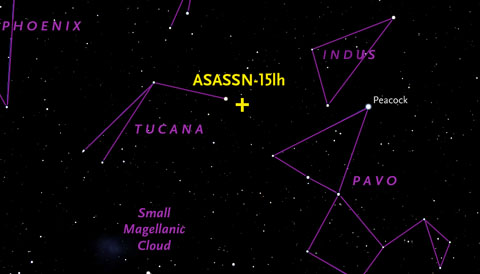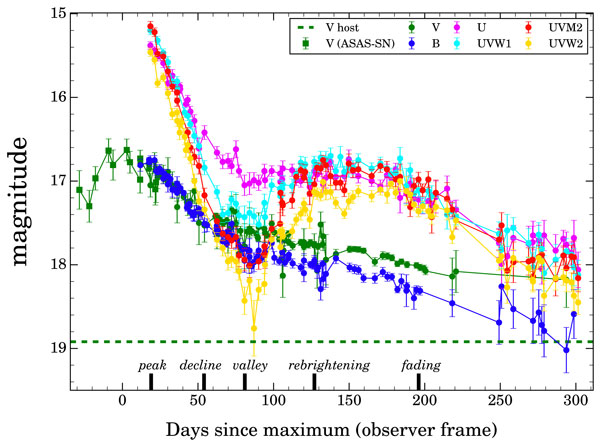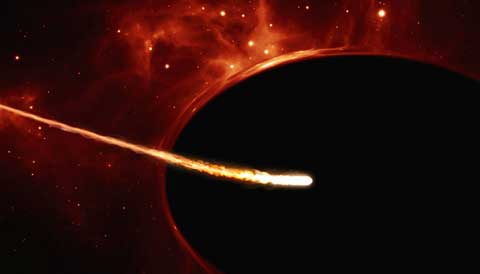Astronomy - “Brightest Supernova Ever” or Shredded Star?
An incredible blaze of light discovered more than a year ago still has astronomers baffled as to its cause. The answer (supernova or black-hole-shredded star) may be contrary to recent headlines.

Artist's rendering of a supernova explosion.
NASA / CXC / M.Weiss/em>
NASA / CXC / M.Weiss/em>
Hailed as the “most luminous supernova,” an object dubbed ASASSN-15lh discovered in 2015 appeared to be the death of an extreme type of star, exploding with twice the brightness of any other known supernova.
However, the superluminous supernova scenario had its drawbacks, and a recent press release with the title, “‘Brightest Supernova’ Not a Supernova, But a Star Ripped Apart by a Spinning Black Hole,” appears to tip the tables in favor of an entirely different explanation.
But lest that definitive title lead you astray, know that the debate is far from settled. “The behavior we saw in ASASSN-15lh . . . was unprecedented for either a supernova or a tidal disruption event,” says Peter Brown (Texas A&M University), who has conducted independent analysis of the data. Yet, though the extreme burst doesn’t fit either explanation perfectly, the new study does open the theoretical playing field.
What Is ASASSN-15lh?

An extremely luminous supernova, designated ASASSN-15lh, flared to magnitude 17 in late May 2015. It has now largely faded away.
Sky & Telescope diagram; source: Stellarium
Sky & Telescope diagram; source: Stellarium
Subo Dong (Peking University, China) discovered ASASSN-15lh’s blaze of light on June 14, 2015. At its peak, its brightness had soared to a visual magnitude of 17. That may not sound bright (it’s out of reach for the average backyard telescope), but given that its light had to travel 3.8 billion years to get here, it’s equivalent to the light from 572 billion Suns.
Initially, the object’s spectrum displayed a peculiar feature that astronomers couldn’t explain. But they’d seen it before in other superluminous supernovae, bursts so bright that they defied the usual physics of exploding stars.
A number of explanations have been tossed around to explain these objects, including magnetars (neutron stars with extremely powerful magnetic fields) or extremely massive stars. Suffice it to say, superluminous supernovae aren’t well understood, but they do have typical qualities and this new object appeared to match them. Using the superluminous scenario, Dong and colleagues predicted that the object would display magnesium lines in its spectrum, and subsequent measurements from the SALT telescope in South Africa showed the lines as predicted.
Then ASASSN-15lh threw researchers for another loop — as it was in the process of fading away into obscurity, it suddenly got brighter. For reasons still unknown, superluminous supernovae sometimes do this, so this rebrightening still fit into the supernova narrative.

This plot shows how ASASSN-15lh's light faded — and rebrightened — over time. The green circles and squares show visible light, while cyan, red, and yellow circles depict ultraviolet light. The visible light peaks at Day 0 and then fades over time. Ultraviolet light shows two peaks, though. Ultraviolet radiation starts increasing again around 90 days after the supernova's maximum light and plateaus for awhile before fading again.
Godoy-Rivera et al. 2016
Godoy-Rivera et al. 2016
Meanwhile, another idea had been considered and dismissed by many: a tidal disruption event. If a star passes too near a supermassive black hole, the immense gravitational fields will shred the star to pieces. The stellar remains heat up as they spiral into the black hole, glowing briefly before they’re consumed.
ASASSN-15lh flashed into existence very near the center of a big galaxy. So had the galaxy’s central black hole torn apart a star? Researchers considered it unlikely — the elliptical galaxy was so big that its supermassive black hole was probably at least 100 million times the mass of the Sun: big enough to swallow stars whole without emitting light at all.
Hungry Black Holes

This artist’s impression depicts a sun-like star close to a rapidly spinning supermassive black hole, with a mass of about 100 million times the mass of the Sun, at the center of a galaxy.
ESO / ESA / Hubble / M. Kornmesser
ESO / ESA / Hubble / M. Kornmesser
A new study by Georgios Leloudas (Weizmann Institute of Science, Israel, and University of Copenhagen, Denmark) and colleagues, which appears in the December 12th Nature Astronomy, refines earlier observations using new data from the Hubble Space Telescope — and brings the black hole scenario back into play.
A key result is an update on ASASSN-15lh’s location. While discovery data had placed it near the galaxy’s center, this study improves the precision by a factor of four, placing the light source within 1,000 light-years of the center and possibly in the center itself.
Spectroscopy from Hubble also reveals ions that only exist in extremely hot environments, such as quadruply ionized nitrogen and quintuply ionized oxygen. These ions are typically associated with supermassive black holes actively gobbling down gas, and have been seen before in other tidal disruption events.
The team also thinks they’ve found another telltale of black-hole gobbling: a wide hydrogen line that indicates gas swirling around at speeds roughly 2,500 kilometers per second (6 million mph, or 1% of the speed of light). The lack of such a broad line until now was part of what had initially dampened prospects for a tidal disruption event explanation.
Altogether, the speed and heat of the gas associated with ASASSN-15lh, as well as its location near or in the center of its galaxy, make a convincing argument for the black hole scenario. A simulation of a tidal disruption event is shown below:
Most importantly, the team argues that while the galaxy’s supermassive black hole is probably greater than 100 million solar masses, it’s also probably spinning. Spinning black holes have a harder time gulping stars whole, so this black hole could easily shred a star if it’s spinning fast enough. Recent studies of nearby galaxies show that spinning supermassive black holes are the norm at least in our galaxy’s neighborhood.
Finer Points
Nevertheless, the new data and arguments are far from definitive, argues Dong. And even Leloudas’s team and Brown agree that the superluminous supernova scenario can’t be ruled out.
For example, ASASSN-15lh’s location by itself doesn’t rule out a magnetar supernova — in fact, a magnetar was only recently discovered within three light-years of our own galaxy’s center.
And the hydrogen that Leloudas’s team found — the one that looks like gas swirling near a black hole’s gravitational vortex — might not be so speedy after all. In another recent paper, Raffaella Margutti (Harvard University) and colleagues used the 6.5-meter Magellan Clay telescope space telescope to measure a higher-resolution spectrum, which shows the apparently wide line might instead be a combination of a couple of narrow lines, representing slower-moving gas.
Leloudas’s team writes, “Our observations are more consistent with a tidal disruption event than a superluminous supernova . . .”, but Brown and Dong both disagree with that statement. Dong argues that the supernova scenario wins based on available observations.
Meanwhile, Brown says, “If I had to pick a side, I’d lean towards the black hole interpretation. But I’d like to see more theoretical models backing it up. . . . Hopefully, this paper will kick start that.”
If there’s one thing everyone agrees on, it’s that there’s no definitive answer just yet. Neither scenario has been entirely ruled out or proven correct. And whatever ASASSN-15lh is — whether it’s a supernova or a hungry black hole — it’s like none we’ve ever seen before.
No comments:
Post a Comment